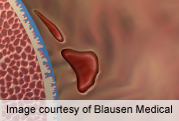
THURSDAY, Aug. 2 (HealthDay News) — A pharmaceutical company says preliminary findings support a spray-on treatment that uses skin cells to speed the healing of venous leg ulcers, a condition that often strikes the elderly.
The treatment hasn’t gone through all the research necessary before it can become available in the United States, and the approval process will take years. Also, it’s not clear how much the treatment will cost, and it’s possible that future research will reveal side effects.
Still, the findings are promising and important because “current treatments are not able to heal everyone,” said Dr. Herbert Slade, chief medical officer of Healthpoint Therapeutics, which funded a study into the treatment. “In the area of chronic wound care, our study stands out as being well-designed, well- conducted, sufficiently large to be meaningful and, best of all, the treatment shows very good efficacy thus far.”
An estimated one in 50 older Americans suffers from the leg ulcers, which can develop after the blood in veins backs up, perhaps due to blood clots, Slade explained. The backed-up blood seeps into tissue and makes them more susceptible to injury, he said.
“The ulcers are usually caused by mild trauma, like bumping your leg or ankle into a hard object,” he said. “If you don’t get the ulcer treated quickly, or if it doesn’t respond to standard treatment, it becomes a chronic wound.”
Physicians often recommend compression bandages to push the blood back up the veins, but the treatment — along with care of the wound itself — only works 30 percent to 70 percent of the time, Slade said. “If this standard approach doesn’t work, there are very few options,” he said. “Doctors have used skin grafting in some cases, but that requires making another wound on your body.”
The new treatment attempts to coax the body into healing itself with the use of human skin cells. The cells “provide help and instructions to cells within the wound, so you end up healing yourself,” Slade said. “The cells from the treatment only live for about two weeks, then they’re gone.”
The new study, which Slade co-authored, is phase 2 research designed to understand how well a treatment works. A third phase of research, which compares a new treatment to an existing treatment, is needed before the federal government will approve a drug.
In the current study, researchers gave different doses of the treatment to 178 patients and a placebo to 50 patients. The participants had the most healing on a low dose given every two weeks: After 12 weeks, ulcers had healed in 70 percent of patients, compared with 46 percent of those who received a placebo.
“The treatment effect was seen very rapidly, with wounds beginning to heal already in the first week,” Slade said.
The researchers found that those who received the placebo were more likely to report problems — potential side effects — than those who got the actual treatment. The study says most of the problems, such as new ulcers, were “non-serious” and most were resolved.
The findings “offer great hope for patients with chronic wounds,” said Dr. Matthias Augustin, director of the Institute for Health Services Research in Dermatology and Nursing at the University Clinics of Hamburg in Germany, who wrote a commentary accompanying the study.
With non-healing ulcers, prolonged traditional treatments drive up cost without helping patients, and new products need to be evaluated for wound healing and cost effectiveness, he noted in the commentary.
The study appears online Aug. 3 in The Lancet.
More information
For more about skin ulcers, try the U.S. National Library of Medicine.

